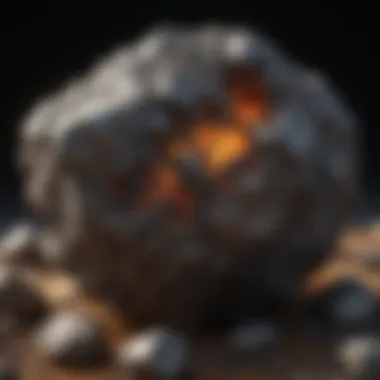Unraveling the Enigma: The Found Meteorite's Intriguing Tale


Rock and Fossil Identification
Delving into the intriguing realm of meteorites begins with a thorough understanding of their composition and characteristics. Meteorites are extraterrestrial rocks that have survived the intense journey through Earth's atmosphere to land on its surface. These specimens hold vital clues about the formation and history of our solar system, making their identification a crucial pursuit for scientists and enthusiasts alike.
Types of meteorites range from stony to metallic, each exhibiting unique features that hint at their origins. Stony meteorites, comprising silicate minerals and often displaying chondrules, offer valuable insights into the early processes of planet formation. On the other hand, metallic meteorites, primarily composed of iron and nickel, shed light on the metal-rich cores of asteroids.
Identifying meteorites involves scrutinizing various key characteristics such as fusion crust, regmaglypts, and inclusions. The fusion crust, formed by melting during entry into Earth's atmosphere, acts as a protective layer preserving the pristine interior of the meteorite. Regmaglypts, carved indentations caused by ablation during its descent, provide clues to its flight path and orientation. Inclusions, embedded particles within the meteorite structure, can unveil fascinating details about the cosmic environment in which they formed.
Utilizing specialized tools like a magnet, streak plate, and acid test can aid in the identification process. Their magnetic properties distinguish iron meteorites, while the streak test, revealing the color of the mineral powder, helps differentiate between certain meteorite classes. The acid test assists in confirming the presence of certain minerals, contributing to precise classification and understanding of the sample.
Collecting Tips and Techniques
Embarking on a meteorite collection journey requires adherence to best practices to ensure the authenticity and preservation of specimens. Collectors should prioritize observing established guidelines to contribute valuable data to the scientific community while enriching their personal collections.
Choosing prime collecting sites plays a critical role in determining the success of a meteorite hunt. Locations with minimal vegetation cover, such as deserts or ice fields, offer higher chances of spotting fallen meteorites due to their expanse and visibility. Remote areas far from light pollution also present advantageous conditions for meteorite hunting, enhancing the probability of discovering pristine specimens.
Implementing safe techniques for specimen extraction is paramount to avoid contamination and damage. Collectors should utilize gloves and sterile tools to handle meteorites, preventing potential alterations to their composition. Proper documentation of the find location and circumstances, including GPS coordinates and date of discovery, strengthens the specimen's scientific value and authenticity.
Preservation and Display
Preserving and showcasing meteorite specimens require meticulous attention to retain their structural integrity and aesthetic appeal. Effective preservation techniques ensure the longevity of the specimen while maintaining its scientific and educational value.
Various methods such as coating with lacquer or resin protect the meteorite surface from oxidation and external elements, safeguarding its pristine state. Proper storage practices, including placing the specimen in a sealed container with desiccants to control moisture levels, prevent deterioration and ensure longevity.
Creative display ideas enhance the visual impact of meteorites, captivating audiences and fostering interest in these extraterrestrial treasures. Mounting meteorites on stands or frames, accompanied by informative labels detailing their classification and origin, enriches the viewing experience. Utilizing lighting effects to highlight unique features and textures of the meteorite further accentuates its aesthetic appeal.
Geological Insights
Exploring the geological significance of meteorites unveils a wealth of knowledge about cosmic phenomena and Earth's history. These extraterrestrial rocks not only offer insights into the processes of planet formation but also provide a window into the dynamic interactions shaping our solar system.


The study of meteorites informs our understanding of geological formations and processes on Earth and other celestial bodies. Comparing meteorite compositions with terrestrial rocks aids in tracing the evolution of planetary bodies and identifying commonalities in their chemical signatures. Meteorites hold historical significance as relics from ancient cosmic events, offering glimpses into the volatile history of our solar system.
Numerous notable discoveries in the field of meteoritics have expanded our understanding of planetary science and the origins of celestial bodies. From the discovery of amino acids in meteorites to the identification of interstellar grains, each find contributes valuable data to unraveling the mysteries of our universe and the cosmic processes at play.
Introduction
In the realm of scientific discoveries, few are as enthralling as the unearthing of a meteorite. This article serves as a portal into the captivating narrative surrounding the mystery of a found meteorite, weaving together a tapestry of scientific scrutiny and celestial wonder. From the initial moments of recognition to the profound implications for planetary science, the journey of this meteorite embodies a saga of intrigue and revelation.
As we embark on this exploration, it is crucial to grasp the significance of delving into the heart of such a discovery. The unfolding of this meteorite's tale not only sheds light on its own composition and origin but also offers a glimpse into the vast mysteries that enshroud our universe. By unraveling the intricate details of this celestial visitor, we pave the way for a deeper understanding of our cosmic surroundings.
The primary focus of this article is to provide a comprehensive guide to the meticulous process of uncovering the secrets held within a found meteorite. Through meticulous analysis and detailed examination, each section and subsection will dissect various facets of this phenomenon, offering rock and fossil collectors, along with enthusiasts of planetary science, a profound and knowledge-enriched journey.
Moving forward, we will navigate through the initial buzz of discovery to the meticulous techniques employed in identification, and ultimately, to the scientific impact and classification of this meteorite. It is within these realms that the essence of this enigma resides, waiting to be unveiled and examined in intricate detail.
The Discovery
In this article, we embark on a fascinating journey into the compelling world of meteorites by uncovering the nuances of a found meteorite. The Discovery section plays a crucial role in shedding light on the initial steps and processes involved in unearthing this celestial artifact. From the first moment of recognition to the meticulous techniques used for identification, every aspect contributes significantly to our understanding of meteorites and their profound implications.
Initial Recognition
The Initial Recognition phase marks the genesis of the discovery process, where keen-eyed individuals stumble upon what could potentially be a meteorite. The significance of this phase lies in the critical observational skills required to discern a meteorite from common rock formations. It involves a keen understanding of meteorite characteristics such as fusion crust, regmaglypts, and possible magnetic properties that differentiate it from terrestrial rocks. Scientists and collectors alike rely on years of experience and expertise to accurately identify these extraterrestrial gems amidst ordinary geological specimens.
Collection Process
Following the momentous discovery and initial recognition, the Collection Process sets the stage for carefully retrieving the meteorite from its landing site. This phase involves meticulous planning and execution to ensure the preservation of vital information regarding its context of origin. Collectors must adhere to strict protocols to avoid contamination and minimize alteration of the meteorite's pristine state. Each step in the collection process is critical as it directly impacts the subsequent analyses and interpretations that will unfold during the investigation.
Identification Techniques
Delving deeper into the intricacies of meteorite analysis, the Identification Techniques employed in this study are at the forefront of scientific innovation. Advanced imaging technologies, spectroscopic analyses, and X-ray diffraction methods play a pivotal role in unraveling the composition and structure of the meteorite. By combining cutting-edge techniques with traditional mineralogical approaches, researchers can establish a comprehensive profile of the meteorite, detailing its chemical makeup, crystalline structure, and possible formation history. These techniques not only enhance our understanding of the meteorite but also pave the way for groundbreaking insights into the mysteries of space and planetary evolution.


Meteorite Properties
In this detailed article unraveling the mystery of a found meteorite, the section on Meteorite Properties holds a significant role in shedding light on the intrinsic characteristics of these celestial objects. Understanding Meteorite Properties is paramount in comprehending the nature of meteorites, their origins, and the valuable insights they offer to the scientific community and beyond.
Physical Characteristics
Physical Characteristics of meteorites offer a wealth of information that aids in unraveling their journey through space and their interaction with the Earth upon impact. Meteorites exhibit a variety of physical features, including shape, size, texture, and fusion crust. Analyzing these characteristics provides crucial clues about the environment in which the meteorite formed, its path through the atmosphere, and the conditions it experienced during entry.
Chemical Composition
Delving into the Chemical Composition of meteorites unveils a treasure trove of data essential for understanding their makeup and origins. Meteorites harbor a diverse array of elements and compounds that offer insights into the processes occurring in the early solar system, such as nucleosynthesis and elemental abundances. By scrutinizing the chemical composition of meteorites, scientists can trace their source regions and infer conditions prevailing during their formation.
Geological Significance
The Geological Significance of meteorites extends far beyond their extraterrestrial origin, transcending into the realm of Earth's geological history. Studying meteorites provides a unique perspective on geological processes, impact events, and planetary evolution. Meteorites can act as time capsules, preserving information about early Solar System events and offering clues about the geological dynamics of celestial bodies beyond Earth. Unraveling the geological significance of meteorites contributes to a deeper understanding of both Earth's history and the broader cosmic landscape.
Scientific Impact
The scientific impact of this meteorite is multifaceted, offering researchers a unique opportunity to peer into the geologic history of our solar system. Through advanced analytical techniques, such as spectroscopy and isotopic dating, scientists can decipher clues embedded within the meteorite, unveiling stories of ancient planetary processes and cataclysmic events that shaped our celestial neighborhood. These discoveries not only deepen our understanding of planetary formation but also hold the key to deciphering the origins of life on Earth.
Furthermore, the scientific impact extends to broader astronomical studies, providing researchers with data points that contribute to a greater mosaic of knowledge about our universe. By contextualizing the findings from this meteorite within the wider research landscape, scientists can draw parallels between different celestial bodies, enriching our understanding of cosmic evolution and the interconnectedness of planetary systems. In essence, the scientific impact of this meteorite transcends its physical existence, serving as a gateway to unlocking the secrets of the cosmos.
Planetary Science Insights
Within the realm of planetary science, the discovery of this meteorite offers a treasure trove of insights that have the potential to transform our understanding of celestial bodies. By studying the chemical composition and isotopic ratios of the meteorite, researchers can reconstruct the environmental conditions present during its formation, providing crucial data points for modeling planetary processes.
One of the key planetary science insights derived from this meteorite is the revelation of ancient nucleosynthesis events that occurred within the early solar system. Through isotopic analysis, scientists can trace the origin of elements within the meteorite back to stellar processes, offering a glimpse into the cosmic alchemy that birthed the building blocks of our solar system. This information not only enhances our knowledge of planetary formation but also contributes to our understanding of the elemental abundances across different celestial bodies.
Moreover, the planetary science insights gained from this meteorite play a pivotal role in advancing our comprehension of planetary diversity and evolution. By comparing its composition to known meteorite types and planetary materials, researchers can draw parallels between different bodies within our solar system, unraveling the dynamic processes that have sculpted the planetary landscape over billions of years.


Research Potential
The research potential embedded within this meteorite discovery is vast, offering a myriad of avenues for further exploration and scientific inquiry. One of the primary research opportunities lies in the interdisciplinary collaboration between geologists, chemists, and astronomers to comprehensively analyze the meteorite's composition and properties.
By harnessing cutting-edge analytical techniques, such as mass spectrometry and electron microscopy, researchers can delve deep into the microscopic features of the meteorite, unveiling hidden signatures of its cosmic journey. These detailed analyses not only provide insights into the meteorite's formation process but also pave the way for new avenues of research in cosmochemistry and planetary geology.
Furthermore, the research potential of this meteorite extends to astrobiological investigations, offering scientists a glimpse into the potential habitats for microbial life within the solar system. By studying the presence of organic compounds and water-bearing minerals within the meteorite, researchers can infer the conditions necessary for life to thrive on other celestial bodies, expanding the frontiers of astrobiological research.
Meteorite Classification
Meteorite Classification serves as a fundamental framework that aids scientists and researchers in deciphering the diverse nature of meteorites. It enables the differentiation of meteorites based on various criteria such as their mineralogical composition, texture, and isotopic signatures. Through this classification process, experts can discern between different meteorite types, allowing for a more nuanced understanding of their formation and evolution.
Moreover, Meteorite Classification plays a crucial role in unraveling the mysteries of our universe by providing clues about the diverse sources of meteorites. It offers a systematic approach to identify patterns and connections between different meteorite groups, shedding light on the complex processes that have shaped our solar system.
Within the context of this article, Meteorite Classification will be explored comprehensively, highlighting its significance in revealing the intricate diversity of meteorites and its implications for advancing our knowledge of space and planetary science.
Study Findings
In the realm of meteorite exploration, the study findings play a pivotal role in unraveling the mysteries surrounding these celestial visitors. Within the context of this article, the study findings provide a cornerstone for understanding the nuances of the found meteorite. Through meticulous analysis and scientific scrutiny, researchers have unearthed invaluable insights into the meteorite's origin, composition, and potential implications for planetary science. The study findings act as a gateway to comprehending the broader significance of this discovery, shedding light on the complexities that lie within these extraterrestrial specimens.
Microscopic Analysis
Delving into the microscopic realm is imperative in deciphering the intricate details encoded within a meteorite. In this section, we take a closer look at the microscopic analysis conducted on the found meteorite. By scrutinizing the minute features and structures present at a microscopic level, scientists gain a granular understanding of the meteorite's internal composition, crystalline structure, and possible traces of extraterrestrial minerals. Through sophisticated imaging techniques and advanced microscopy tools, researchers can unveil the hidden secrets that the naked eye cannot perceive, offering a glimpse into the cosmic journey of the meteorite before its earthly landing.
Isotopic Dating Results
The isotopic dating results provide a key to unlocking the time capsule stored within the meteorite. By scrutinizing the isotopic ratios of certain elements within the specimen, scientists can deduce the age of the meteorite and trace back its origins to the vast expanses of space. In this section, we present a detailed analysis of the isotopic dating results obtained from the found meteorite. These findings not only offer a glimpse into the meteorite's formation and history but also enable researchers to piece together the timeline of events that have shaped its trajectory through the cosmos. The isotopic dating results serve as a chronicle of the meteorite's cosmic voyage, providing a window into the ancient past of our solar system.
Conclusion
One of the primary benefits of this conclusion is its ability to bring cohesion to the diverse information discussed in the preceding sections. By synthesizing the insights gained from the meteorite's properties, scientific impact, classification, and study findings, the conclusion provides a holistic view of the meteorite and its significance within the scientific community. This holistic perspective allows readers, especially rock and fossil collectors, to grasp the interdisciplinary nature of meteorite study and its broader implications beyond mere geological significance.
Moreover, the conclusion offers a deeper understanding of how meteorite discoveries can shape our knowledge of planetary science and the universe at large. By emphasizing the research potential uncovered through the study findings and the geological significance of meteorites, the conclusion prompts readers to contemplate the vast expanse of knowledge waiting to be unraveled through meteorite research. This excites the curiosity of rock and fossil collectors, drawing them into the fascinating world of meteorites and the mysteries they hold.
Additionally, the conclusion of this article acts as a gateway for readers to ponder the rarity assessment of meteorites and the implications for future scientific endeavors. By delving into the rarity assessment and type determination of meteorites, the conclusion prompts reflection on the uniqueness of each meteorite and the valuable insights they offer into Earth's origins and beyond. This encourages rock and fossil collectors to appreciate the rarity and complexity of meteorites, fostering a deeper connection with these celestial marvels.







